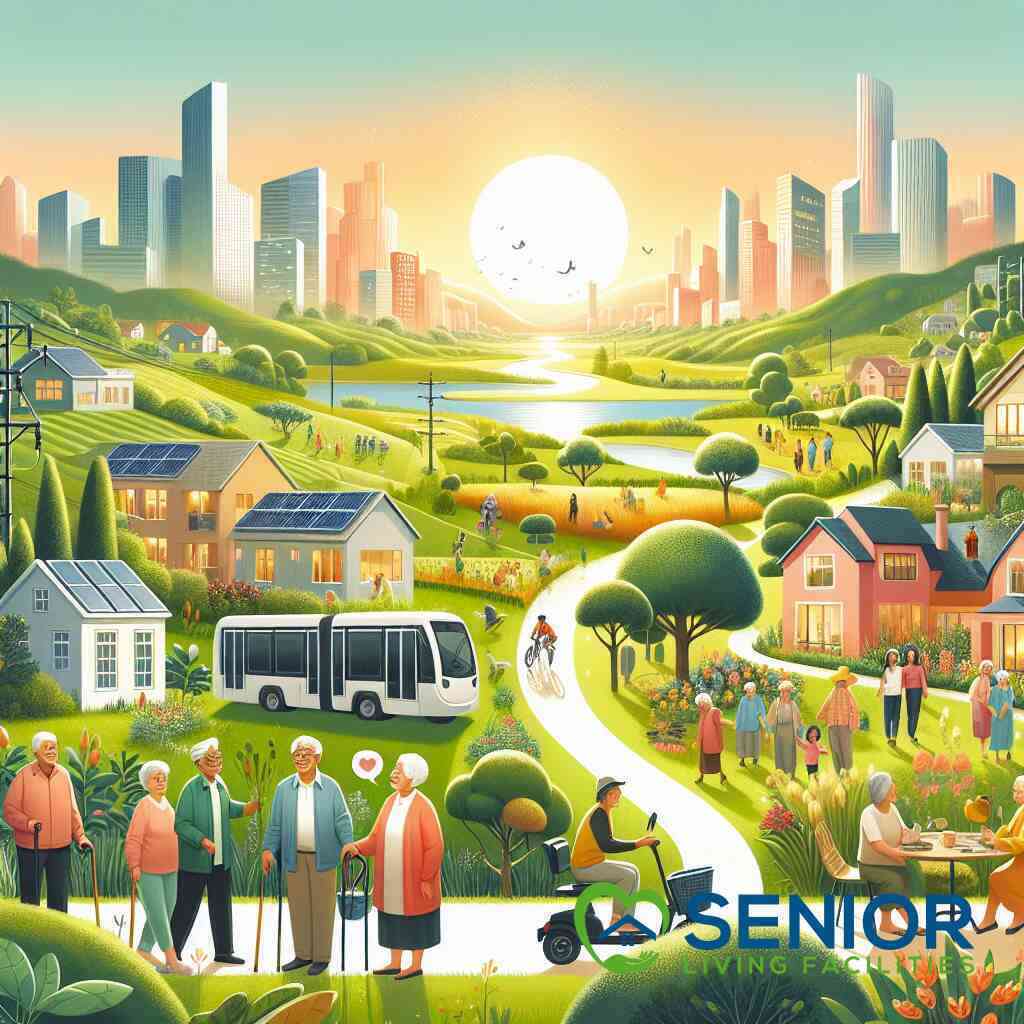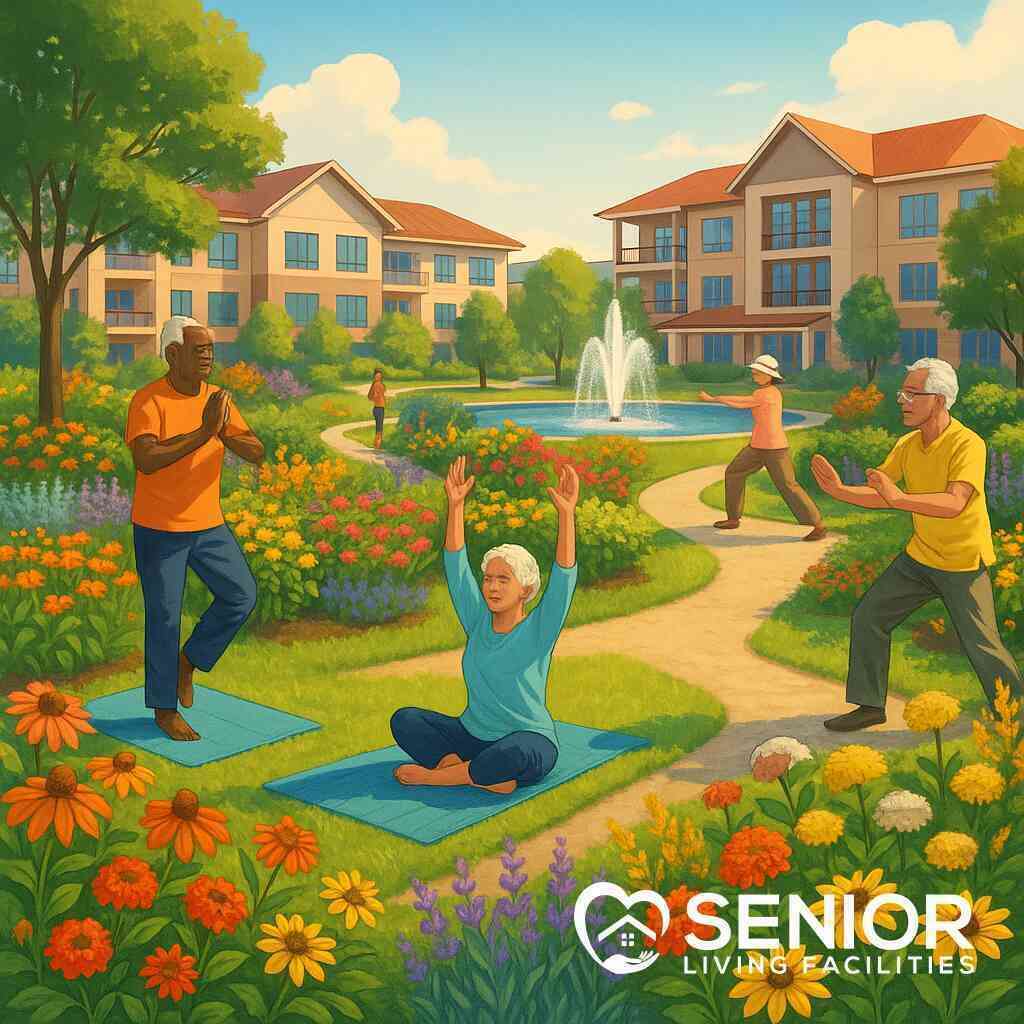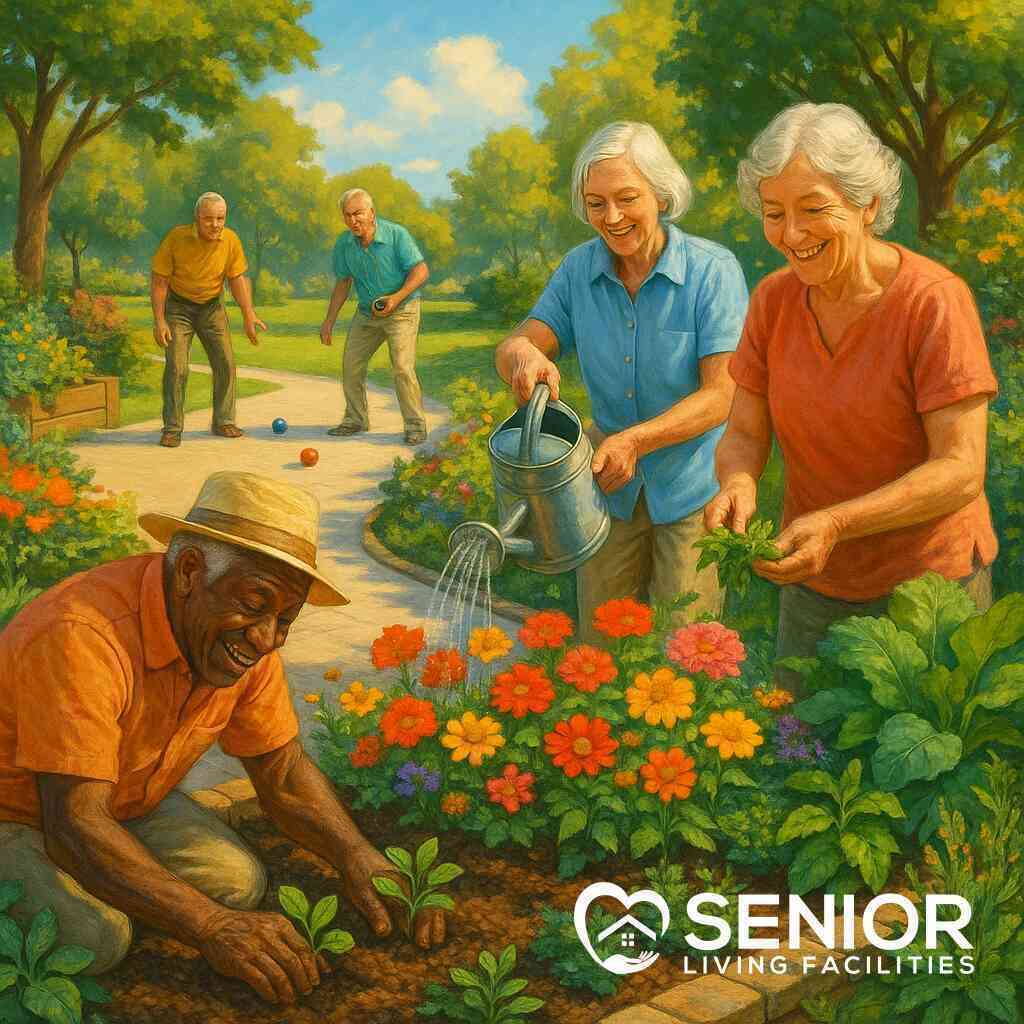
Comparing Senior Facilities: Rural Versus Urban Insight
July 8, 2025
Exploring the Landscape of Senior Living: An Introduction
The Evolution of Senior Living Communities
Senior living communities have undergone significant transformations over the years, evolving from institutional settings to more inviting, community-like environments. Initially, senior living facilities were often indistinguishable from hospital-like institutions. However, the modern approach emphasizes comfort, independence, and enhancing the quality of life for seniors. This evolution aligns with the history of senior living communities, which highlights a shift towards fostering vibrant and engaging environments for seniors. Nowadays, these communities incorporate elements such as eco-friendly designs and wellness-focused amenities to better meet the nuanced needs of aging populations across both urban and rural landscapes.
Understanding the Distinct Needs of Seniors
Understanding the distinct needs of seniors is crucial in crafting environments that support their aging journey. Seniors require accommodations that balance their desire for independence and the necessity of support services. Many facilities offer a range of services like in-home care, assisted living, and more tailored plans to cater to varying levels of health and mobility. These services often include assistance with activities of daily living for seniors, ensuring that residents can maintain a sense of autonomy while receiving necessary aid. In both rural and urban setups, meeting these needs requires thoughtful integration of care and community engagement, allowing seniors to thrive cognitively, socially, and physically within their chosen environment.
Rural vs Urban Senior Care Defined
The definition of rural versus urban senior care revolves around key differences in lifestyle, accessibility, and available amenities. Urban senior living options often boast close proximity to healthcare services, cultural events, and diverse dining and shopping experiences. This can significantly enhance a senior’s lifestyle, providing easier access to varied and enriching experiences. Conversely, rural senior living offers the advantages of serene environments, larger living spaces, and a tight-knit community atmosphere, which can be beneficial for those seeking tranquility and a slower pace of life. However, it’s important to note that senior living lifestyle differences can vary widely depending on the location, available infrastructure, and individual community dynamics. Tailoring senior care to fit these contrasting environments involves creating adaptive strategies that prioritize personalized services and environmental considerations to uphold a high quality of life for residents.
Assessing Costs and Affordability in Senior Housing
Comparative Cost Analysis: Rural and Urban Senior Facilities
The cost structure between rural and urban senior facilities can vary significantly, affecting affordability and access. In urban areas, the demand for space tends to drive up the cost of independent senior living and other housing options for seniors. Urban senior living facilities often offer various premium amenities, which can contribute to higher costs. Conversely, rural facilities may offer more affordable senior housing, primarily due to the lower cost of land and operating expenses in those areas. This comparative analysis highlights the need for families to carefully evaluate their options in both settings. For those interested in a deeper look at these dynamics, exploring a senior living facilities comparison is recommended.
Affordability Challenges in Urban Senior Housing
Urban senior housing often presents affordability challenges due to the higher costs of living associated with metropolitan areas. Seniors seeking housing options for seniors in dense urban environments may find that rental housing for seniors can exceed their budget caps, with limited government or community-subsidized options available. Despite these hurdles, urban areas do offer distinct advantages, such as proximity to medical service access in urban senior care and diverse cultural activities, which remain compelling draws for seniors. However, navigating these financial challenges requires a strategic approach, potentially exploring options for affordable senior housing in urban areas that balance cost with desired amenities.
Economic Benefits of Rural Senior Living
Rural senior living often provides economic benefits that attract families seeking value-driven options for senior care. The lower cost of land and labor can translate to more competitive pricing for seniors living in rural environments, potentially offering increased living space and personalized care services without the financial pressure found in urban facilities. Additionally, rural communities may focus on fostering community engagement through various local cultural events and interactions, enhancing the quality of life. While rural senior living offers economic benefits, it also requires addressing transportation and healthcare delivery challenges, pushing facilities to innovate and adapt. For example, understanding the economic benefits of rural senior facilities helps outline how these areas capitalize on their unique attributes to provide cost-effective and satisfying living options for seniors.
Access and Availability of Medical Services
Understanding Regional Variances in Medical Care
Regional differences in medical care availability greatly impact the nature of senior care in both urban and rural settings. Urban regions generally offer a richer variety of specialized medical facilities and senior care accessibility due to their higher population density and healthcare infrastructure. Seniors in these areas benefit from proximity to hospitals, specialists, and advanced medical technology, contributing to better overall health outcomes. Conversely, rural areas face challenges like fewer healthcare facilities and limited access to specialists, necessitating innovative approaches to ensure quality care. Understanding these regional variances is crucial, as they influence decisions on where seniors should seek care and what level of medical services they can expect. Families must weigh these factors carefully, especially when considering personalized care in diverse environments, as they directly affect the daily lives of seniors and their access to healthcare.
The Role of Proximity in Urban Medical Service Accessibility
The proximity of medical services plays a pivotal role in urban senior care, making cities an attractive option for many seniors. Urban senior living options often provide convenient access to a variety of healthcare services, including routine check-ups, emergency care, and specialized treatments, contributing significantly to the overall quality of life in urban senior care environments. Moreover, the availability of reliable public transportation and shorter distances between health facilities and senior living communities enhance the accessibility of these essential services, minimizing stress and ensuring timely medical attention. This ease of access is a major factor for seniors who prioritize immediate and convenient medical care options. While urban living may pose affordability challenges, the trade-off can be worthwhile given the advantages in healthcare access.
Rural Health Care Solutions: Innovations and Challenges
Rural senior living facilities must navigate unique challenges in delivering comprehensive medical care, often turning to innovative solutions to bridge accessibility gaps. Telemedicine has emerged as a pivotal innovation, facilitating consultations with specialists without requiring seniors to travel long distances. Additionally, partnerships with larger healthcare systems can provide welcome support to small rural facilities, ensuring that seniors receive necessary medical services. Nonetheless, challenges such as limited transportation options and fewer healthcare providers persist, demanding continuous adaptation and resourcefulness. By focusing on innovations in rural health solutions, communities can better meet the needs of their senior populations, creating a supportive and nurturing environment that rivals urban offerings. The balance between cost-effectiveness and innovation remains key to enhancing rural healthcare delivery and ensuring that seniors receive the highest standards of care possible.

Cultural and Social Dynamics in Senior Communities
Community Engagement and Social Experiences: Rural vs Urban
In both rural and urban senior living environments, community engagement plays a pivotal role in shaping the daily experiences of residents. Urban senior facilities often benefit from a vibrant tapestry of cultural activities, events, and numerous opportunities for socializing, which significantly enrich the social experiences for seniors. The abundant social experiences for seniors in urban environments can include attending theater performances, participating in diverse classes, and enjoying community festivals. On the other hand, rural senior communities may emphasize personalized interactions and foster deeper connections among residents due to the smaller and more intimate settings. Community engagement in senior living becomes an indispensable aspect in both contexts but is especially critical in rural areas where fewer external social outlets exist. Facilitating robust community experiences helps nurture a sense of belonging and improves the overall quality of life, regardless of the setting.
Local Culture and Its Impact on Senior Living Facilities
The local culture significantly influences the atmosphere and operations of senior living facilities. In urban settings, the cultural dynamics in senior facilities often reflect the diversity and fast-paced nature of city life. These environments are frequently rich with a variety of cultural influences that contribute to dynamic programming and multicultural dining options. Conversely, rural senior facilities are more likely to embody local traditions and customs, incorporating community events and farm-to-table dining experiences that resonate with their environment. A facility’s ability to embrace and integrate local culture can enhance resident satisfaction, providing a familiar and comforting backdrop that aligns with the seniors’ personal histories and preferences. Understanding these cultural dynamics is crucial for facilities striving to offer residents a living experience that feels both genuine and engaging, thus promoting a sense of community and continuity.
Addressing Isolation: Strategies for Connectivity in Rural Areas
Isolation poses a unique challenge for seniors living in rural areas, where distances can limit regular social interaction. However, numerous strategies exist to counteract this isolation by creating more connected communities. Implementing technological solutions, such as high-speed internet and virtual social platforms, allows rural seniors to stay in touch with family and friends, while telehealth services can facilitate medical care without requiring travel. Social initiatives, such as community shuttle services for events and collaboration with local organizations to host regular meet-ups, further enhance connectivity. Innovations like these can significantly combat the effects of isolation, making rural living more attractive by enhancing the quality of life for seniors. Addressing isolation effectively requires both innovative thinking and strategic planning, ensuring that seniors in rural areas maintain an active, engaged, and fulfilling lifestyle tailored to their unique environment.
Environmental and Lifestyle Considerations
Environmental Adaptations for Senior Living
Environmental adaptations are crucial in senior living, ensuring that facilities are not only safe but also enhance the overall living experience for seniors. Urban communities often lean towards cutting-edge, eco-friendly innovations, such as green buildings and energy-efficient systems, to reduce carbon footprints-elements that are becoming increasingly important in attracting environmentally conscious seniors. Conversely, rural senior living facilities can offer expansive natural landscapes and opportunities for sustainable practices like community gardens. These environmental considerations in senior living reflect a commitment to both ecological responsibility and creating healthy spaces tailored to the needs of seniors. Aligning with these trends, facilities must continuously adapt and innovate their environments to meet regulatory standards and the evolving expectations of current and future residents.
Differences in Daily Lifestyle: Urban and Rural Perspectives
The daily lifestyle of seniors can vastly differ depending on whether they reside in urban or rural settings. In urban areas, seniors often enjoy a diversity of activities and engagements, having access to museums, gyms, and a plethora of classes that keep them mentally and physically active. The vibrant pace and numerous options cater to a lifestyle that is lively and engaging. Meanwhile, residents of rural senior facilities might gravitate towards more leisurely pastimes like nature walks or local craft sessions, offering a slower, more relaxed pace of life that some seniors prefer. These differences are significant in that they influence not only the personal satisfaction of the residents but also their community engagement in senior living. The choice between these environments becomes a matter of personal preference, with each offering unique advantages tailored to different senior lifestyles.
Transportation Options and Their Impact on Senior Mobility
Transportation plays a critical role in how seniors interact with their communities, impacting everything from medical appointments to social outings. Urban senior living benefits significantly from comprehensive public transportation networks, enhancing mobility and independence for seniors who no longer drive. The availability of these networks means that even those in assisted living plans have easy access to essential and leisure destinations. On the other hand, rural areas often struggle with fewer transportation options, which can lead to feelings of isolation for some seniors. Innovative solutions, such as community shuttle services or partnerships with local transportation agencies, are key to improving senior mobility in these environments. Understanding the dynamics of transportation and mobility for seniors is essential in choosing a living situation that best suits their active lifestyle desires and ensures connectivity with the broader community. In both settings, ensuring reliable transportation access can significantly affect a senior’s quality of life and engagement level.
Safety and Quality of Life: A Comparative Assessment
Safety Concerns in Urban and Rural Senior Facilities
Safety remains a pivotal consideration when evaluating senior living facilities, whether in urban or rural settings. Urban senior facilities often face challenges related to higher crime rates, which necessitate enhanced security measures such as gated communities and advanced surveillance systems. Despite these challenges, urban areas benefit from quicker emergency response times due to the proximity of services. In contrast, rural senior living environments generally report lower crime rates, offering a sense of inherent safety. However, these facilities may struggle with slower emergency response times and fewer healthcare resources. Facilities must prioritize safety in senior facilities through robust planning and community collaboration to ensure residents’ well-being in both contexts.
Evaluating Quality of Life Metrics in Senior Living
Evaluating quality of life in senior living involves assessing multiple factors that contribute to a resident’s overall well-being. Urban senior care often excels in providing diverse social and cultural opportunities, enhancing mental and emotional health for residents. Access to high-quality facilities and activities ensures a vibrant lifestyle, aligning with the goals of quality of life in urban senior care. However, urban living can sometimes lead to social isolation due to larger community sizes. Conversely, rural facilities, with their tight-knit communities and tranquil environments, promote close relationships and a slower pace of life, which some seniors find preferable. Each setting offers distinct advantages and challenges, stressing the importance of aligning amenities with seniors’ personal preferences for optimal living conditions.
Personalized Care Approaches for Diverse Environments
Tailoring care to meet the diverse needs of residents is crucial in senior living facilities. Urban environments, with their access to a wide range of specialized medical services, facilitate personalized care approaches that cater to specific health requirements. This access supports a high quality of specialized treatment, meeting the varied needs of the urban senior population. Meanwhile, rural facilities must adopt innovative solutions to overcome limitations in medical service access. Initiatives such as telehealth services and mobile clinics have been instrumental in filling these gaps, demonstrating innovation in personalized care in diverse environments. Both urban and rural settings provide unique opportunities for tailoring care, emphasizing the importance of individualizing resident services to enhance the quality of life.

Conclusive Reflections on Senior Living Environments
Weighing the Pros and Cons: Making Informed Decisions
Selecting the ideal senior living environment involves understanding the pros and cons of senior living environments. Urban senior facilities typically offer abundant resources, cultural activities, and medical services. This urban allure can result in higher expenses and a faster pace of life that may not suit all seniors. On the other hand, rural senior living provides tranquility, spacious living areas, and affordability, appealing to those who value a close-knit community and a slower lifestyle. However, rural areas may struggle with limited healthcare access and fewer entertainment options. Families should thoroughly consider each option’s merits and drawbacks, matching them to the senior’s unique preferences and needs. Making informed decisions ensures that seniors find a community where they can thrive and enjoy a fulfilling life.
Future Trends in Senior Living Facilities
The landscape of senior living is continually being reshaped by emerging trends and innovations. Facilities must adapt to futuristic developments to better serve the evolving needs of seniors. Future trends in senior living include the integration of cutting-edge technologies, which enhance care and operational efficiency. Additionally, there is a growing emphasis on sustainability, with facilities adopting eco-friendly practices to attract environmentally conscious residents. Flexible care models are gaining traction, allowing seniors to seamlessly transition between different levels of care as their health needs change. Awareness of these trends helps families make foresighted decisions, choosing communities that are proactive in meeting future challenges. These advancements promise enhanced living standards, promoting wellness and longevity for seniors in various environments.
Aligning Personal Needs with Living Environment Choices
Ultimately, aligning a senior’s personal needs with their living environment is paramount for their overall well-being. Each senior harbors unique preferences, whether they seek vibrant urban settings or peaceful rural retreats. Facilities can offer tailored care that suits both personal and medical requirements, ensuring a supportive atmosphere. Recognizing personalized care in diverse environments provided by different facilities becomes crucial. Urban locales might better cater to active seniors wanting abundant social engagement and healthcare access. Conversely, rural communities may appeal to those prioritizing affordability and tranquility. By carefully evaluating these factors, seniors and their families can choose an environment that harmonizes with personal lifestyles, encouraging happiness, health, and vitality.
Frequently Asked Questions
Question: What are the primary differences between rural versus urban senior care, and how can Senior Living Facilities help in choosing the right option?
Answer: Rural and urban senior care have distinct characteristics that influence cost, accessibility, and lifestyle. Rural senior living offers serene environments, affordability, and tight-knit communities, whereas urban senior living provides better access to medical services and cultural activities but may come with higher costs. Senior Living Facilities can help families navigate these differences by offering detailed comparisons of amenities in senior communities, helping identify the senior living lifestyle differences, and providing insights into the advantages of both rural senior facilities and urban senior facility benefits. Our platform guides you through finding the ideal community tailored to your personal preferences and needs.
Question: In the blog ‘Comparing Senior Facilities: Rural Versus Urban Insight,’ what factors should families consider when assessing the quality of life metrics in senior living facilities?
Answer: When assessing the quality of life in senior living facilities, families should consider factors such as the availability of personalized care, access to medical services in rural vs urban areas, community engagement, and overall safety. Rural facilities often provide a sense of tranquility and closer connections, while urban facilities offer more cultural opportunities and medical services. At Senior Living Facilities, we ensure you receive a comprehensive evaluation of both rural senior housing affordability and urban senior housing affordability, addressing how safety in rural senior homes and safety in urban senior homes are managed. Our expansive database of senior living options allows families to explore diverse communities and select the one that best aligns with their expectations and needs.
Question: How do environmental considerations for senior living vary between urban and rural areas, and how do Senior Living Facilities assist in finding sustainable options?
Answer: Environmental considerations in senior living vary greatly between urban and rural settings. Urban communities may focus on eco-friendly innovations like green buildings and energy-efficient systems, while rural communities can offer expansive natural landscapes and sustainable practices like community gardens. These environmental factors play a crucial role in the appeal of senior living facilities. Senior Living Facilities is dedicated to helping families find communities that prioritize ecological responsibility. Our services include helping you understand the environmental adaptations in senior living and find communities that align with the desired level of sustainability for seniors seeking an environmentally friendly lifestyle.
Question: What are the transportation options rural vs urban senior living facilities offer, and how does this impact seniors’ quality of life?
Answer: Transportation options are crucial in determining seniors’ ability to access medical services, social activities, and daily needs. Urban senior living benefits from robust public transportation networks, enhancing seniors’ mobility and independence. Conversely, rural areas might struggle with fewer options, often requiring innovative solutions like community shuttles or partnerships with local agencies. Senior Living Facilities provides detailed insights into the transportation dynamics in both settings and how these options impact the quality of life in rural and urban senior facilities. We assist families in selecting communities that ensure accessibility and connectivity, enhancing the daily experiences and engagement levels of seniors.
Question: How do Senior Living Facilities support families in addressing cultural preferences and social experiences for seniors in both rural and urban settings?
Answer: Cultural preferences and social experiences are vital components of seniors’ satisfaction in their living environments. Urban senior living facilities often offer diverse cultural activities and social engagements, while rural facilities may focus on personalized interactions and local culture. Senior Living Facilities understands these nuances and supports families by offering a wide range of senior living options tailored to cultural and social dynamics. Through our platform, you can explore how local culture impacts senior facilities and compare social experiences for seniors, rural vs urban, ensuring that the chosen community reflects the seniors’ lifestyle and preferences, promoting a fulfilling and connected living environment.


